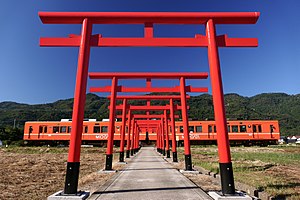| Taisha Line | |||
|---|---|---|---|
 A 1000-series passenger train on the Taisha Line with the Awazu Ino Shrine A 1000-series passenger train on the Taisha Line with the Awazu Ino Shrine | |||
| Overview | |||
| Native name | 大社線 | ||
| Owner | |||
| Locale | Shimane Prefecture | ||
| Termini | |||
| Stations | 5 | ||
| Website | http://www.ichibata.co.jp | ||
| Service | |||
| Type | Heavy rail | ||
| History | |||
| Opened | 2 February 1930; 94 years ago (1930-02-02) | ||
| Technical | |||
| Line length | 8.3 km (5.2 mi) | ||
| Track gauge | 1,067 mm (3 ft 6 in) | ||
| Electrification | Overhead line, DC 1,500 V | ||
| |||
The Taisha Line (大社線, Taisha-sen) is a 8.3 km railway line owned by the Ichibata Electric Railway. The line connects Kawato Station with Izumo Taisha-mae Station, all within Izumo, Shimane Prefecture, Japan.
With the closure of JR West's Taisha Line in 1990, this line became the only line connecting passengers to the Izumo-taisha.
Operations
The line is electrified with overhead lines and is single-tracked for the entire line. No passing loops exist on the line.
Though the line terminates at Kawato Station, some services continue along the Kita-Matsue Line to Matsue Shinjiko-Onsen Station. There are local, express, and limited express services that run along on the line, along with the Izumotaisha express service.
Stations
All stations are within Izumo, Shimane.
| Code | Name | Distance (km) | Connections | |
|---|---|---|---|---|
| 5 | Kawato | 川跡 | 0.0 | Kita-Matsue Line |
| 23 | Takahama | 高浜 | 2.8 | |
| 24 | Yōkan | 遙堪 | 4.8 | |
| 25 | Hamayamakōen-Kitaguchi | 浜山公園北口 | 6.4 | |
| 26 | Izumo Taisha-mae | 出雲大社前 | 8.3 | |
References
- "Timetable" (PDF). Ichibata Electric Railway. 1 April 2017. Retrieved 26 April 2019.
- "Service Route". Ichibata Electric Railway. Retrieved 26 April 2019.
| Stations of the Bataden Taisha Line | |
|---|---|
